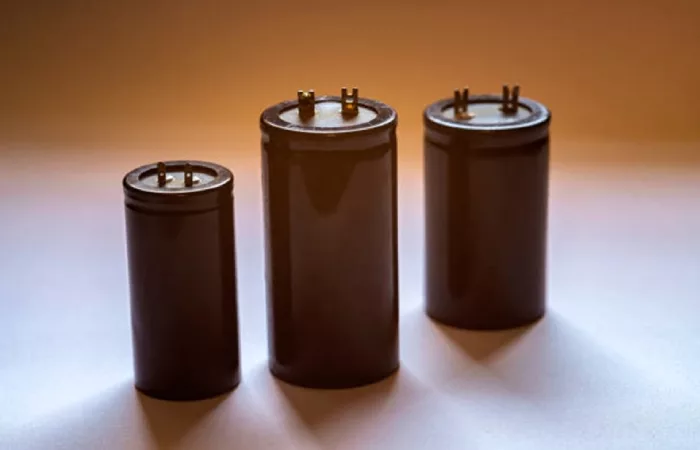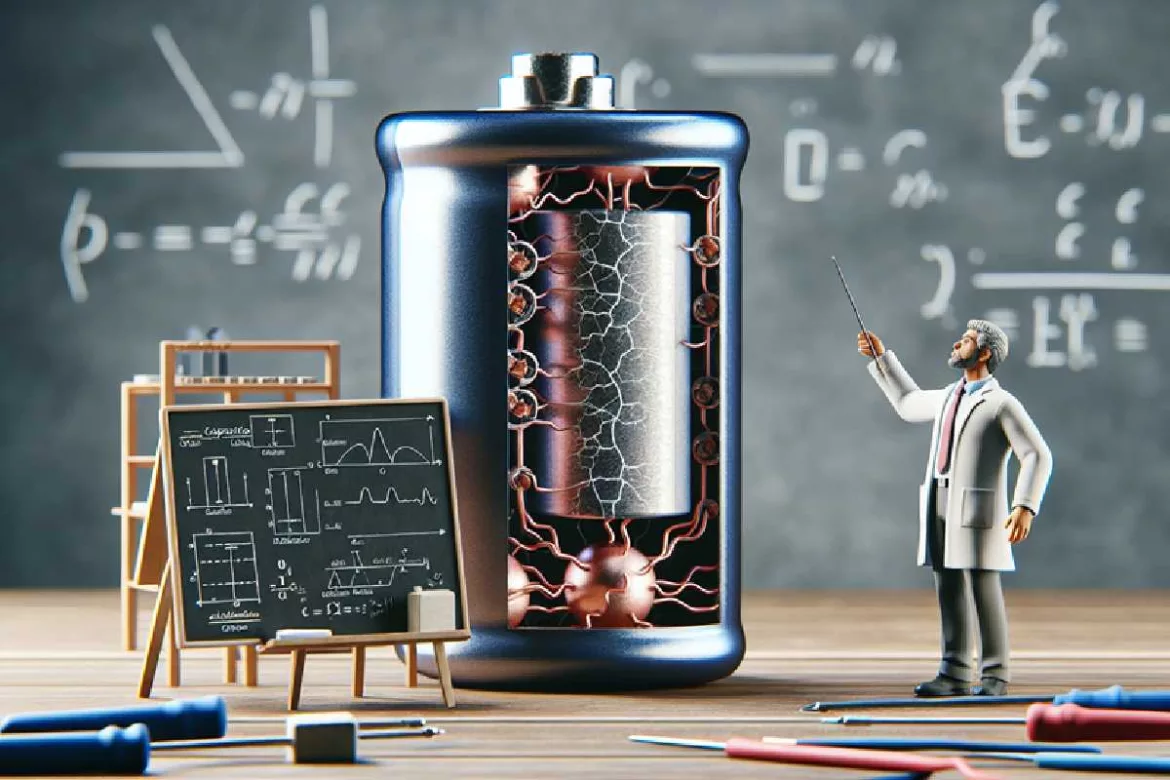Electrolytic capacitors stand as vital components in electronic circuits, their unique construction characterized by an electrolyte or metal oxide offering a pivotal distinction; they employ ions as conductive carriers, diverging from electron-dependent alternatives.
Aluminum electrolytic capacitors, with their substantial capacitance, are indispensable in converting pulsating DC into a more stable form for industrial rectification processes, addressing the demand unmet by film or ceramic counterparts.
This guide delves into the intricate workings of electrolytic capacitors—most notably, aluminum variations—which have established themselves as the preeminent choice within the industry.
Table of Contents
Understanding Electrolytic Capacitors
Electrolytic capacitors distinguish themselves through their unique construction and ability to achieve greater capacitance than other types. At their core, these components consist of two metallic layers, often aluminum, separated by a thin electrolyte layer.
Upon the voltage application, the electrolyte reacts chemically with the aluminum, forming an insulating oxide layer that serves as the dielectric. This oxide layer is central to the capacitor’s ability to store an impressive amount of charge, a characteristic that renders them indispensable in circuits that require high capacitance values.
Polarization and Installation:
Polarized Nature: Electrolytic capacitors are inherently polarized, featuring distinct positive and negative leads. This polarization necessitates careful installation, as reversing the polarity can lead to component damage or failure.
Installation Precautions: To ensure longevity and proper functionality, it is vital to match the voltage and capacitance ratings during replacement. The voltage rating should meet or exceed the circuit’s maximum voltage, while the capacitance should align as closely as possible with the original capacitor’s specifications.
Types and Stability:
Aluminum vs. Tantalum: The two primary variants of electrolytic capacitors are aluminum and tantalum. Aluminum capacitors are more cost-effective and widely used, whereas tantalum capacitors boast higher capacitance per volume and exhibit more excellent stability.
Lifespan Considerations: The lifespan of these capacitors is finite and is adversely affected by factors such as elevated temperatures and voltage fluctuations. Recognizing this, engineers account for these conditions in designing and selecting capacitors for electronic devices.
Failure Modes and Handling:
Potential Failures: Electrolytic capacitors can fail in one of two ways: by becoming an open circuit, which results in a loss of capacitance, or by developing a short circuit, which causes leakage current.
Learn more about leakage current here.
Safe Handling: When dealing with electrolytic capacitors, it is crucial to handle them with care. Even when disconnected from a circuit, these capacitors can retain a charge, posing a risk if the leads or the capacitor’s body are touched inadvertently.
Types and Applications of Electrolytic Capacitors

Electrolytic capacitors, leveraging an electrolyte for enhanced capacitance, are integral to many electronic applications due to their ability to store and manage more significant charge amounts than other capacitor types.
Main Types of Electrolytic Capacitors:
- Aluminum Electrolytic Capacitors: These are the most prevalent, employed across various applications from power supplies to DC link circuits and signal coupling. Their widespread use is attributed to their cost-effectiveness and versatility.
- Tantalum Electrolytic Capacitors: Known for their exceptional stability, low Equivalent Series Resistance (ESR), and high capacitance per volume, tantalum capacitors are the preferred choice for compact electronic devices, such as laptops, requiring space-efficient components.
- Niobium Electrolytic Capacitors: Emerging as an alternative to tantalum types, niobium capacitors offer similar properties with the added benefits of greater availability and reduced cost, presenting an attractive option for manufacturers.
To illustrate their widespread application:
- Power Supply Noise Filtering: Electrolytic capacitors are pivotal in power supplies for noise filtering or decoupling, where they mitigate unwanted variations in voltage and maintain a stable power flow to sensitive components.
- Signal Coupling and Decoupling: These capacitors are also instrumental in coupling and decoupling signals within circuits, ensuring that different stages of an electronic system can function without interference from one another.
- Pulse Circuit Applications: The high capacitance of electrolytic capacitors makes them suitable for pulse circuits, where they can manage the sharp changes in current associated with pulse waveforms.
Challenges and Future Trends
The electrolytic capacitor market is anticipated to experience consistent growth, driven by the ongoing demand for consumer electronics, renewable energy systems, and automotive electronics. As these sectors continue to innovate and expand, the need for reliable and efficient electrolytic capacitors will rise accordingly. However, this growth is not without its challenges and future trends that shape the development of electrolytic capacitor technology.
Market Growth and Demand:
The demand for electrolytic capacitors is closely tied to the growth of industries such as consumer electronics, which are essential for power management and noise suppression in devices ranging from smartphones to televisions.
In renewable energy systems, particularly solar and wind power, electrolytic
capacitors play a crucial role in energy storage and voltage regulation, further driving market expansion. Click here to learn more about the impact of electrolytes on the performance of supercapacitors.
Challenges in the Electrolytic Capacitor Industry:
- Material Scarcity: Tantalum and niobium, used in some electrolytic capacitors, are subject to supply limitations and geopolitical tensions that can affect availability and cost.
- Environmental Concerns: The production and disposal of electrolytic capacitors raise ecological issues due to the use of toxic materials and recycling challenges.
- Technological Advancements: The industry must continually adapt to the miniaturization trend in electronics, requiring smaller capacitors yet providing the same or higher capacitance and reliability.
Advancement in Electrolytic Capacitors technology
Miniaturization and Enhanced Performance:
Nippon Chemi-Con Corporation and its subsidiary, United Chemi-Con Inc., have been at the forefront of this innovation, significantly reducing the case sizes of aluminum electrolytic capacitors by almost five times since 1965. This miniaturization has been complemented by an extended operating temperature range, now spanning from -55 to +130°C, enabling their use in more extreme conditions.
The advancements in plate surface area and thin dielectric layers have allowed for high capacitance and voltage ratings within these smaller, cost-efficient case sizes, optimizing space and cost without compromising the electrolytic capacitor’s essential characteristics.
Emerging Technologies and Applications:
Supercapacitors and nanocapacitors represent the next leap in capacitor technology, with supercapacitors offering much higher energy storage capacity, longer lifespan, and better temperature tolerance.
Nanocapacitors leverage nanoscale materials and fabrication techniques to achieve high energy storage in a minimal form factor.
High-temperature capacitors have expanded the operational boundaries to temperatures up to 200°C or more, using robust materials such as ceramic, tantalum, and other refractory metals, catering to demanding environments and applications.
Go here to learn more about supercapacitor market trends to look out for in the coming years.
Conclusion
Throughout this guide, we’ve explored the intricate workings of electrolytic capacitors, particularly their role in high-capacitance applications, their polar nature and the need for accurate installation, and the diverse challenges they face within the electronic components industry.
As our reliance on technology continues to burgeon, the advancement and adaptability of electrolytic capacitors remain quintessential. They are not just components but catalysts enabling the development of sophisticated electronic devices.
The industry’s response to future challenges, with concerted efforts in research for alternative materials and improved capacitor designs, will be a linchpin for technology to maximize the electrolytic capacitors in emerging applications efficiently.


